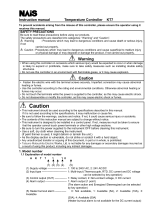
6
5 Operation flowchart
Set value lock
PV
SV
Selection
• Make a selection with , keys.
• If Lock 1 or Lock 2 is selected, AT
does not work.
• Be sure to select Lock 3 when
frequently changing set values via
Serial communication.
[Auxiliary function setting mode 1]
AT
PV SV
Selection
• If AT is cancelled during the process,
PID values revert to previous value.
SV (Desired value)
PV
SV
Integral time
PV SV
Set value
• Set the value with , keys.
• Setting the value to 0 disables the
function.
Derivative time
PV SV
Set value
• Set the value with , keys.
• Setting the value to 0 disables the
function.
OUT1 proportional cycle
PV SV
Set value
• Set the value with , keys.
• Not available if OUT1 is ON/OFF
action or DC current output
Manual reset
PV SV
Set value
• Set the value with , keys.
• Available for P or PD action
ARW
PV SV
Set value
• Set the value with , keys.
• Available for PID action
Alarm value
PV SV
Set value
• Set the value with , keys.
• Not available if is selected
during Alarm type selection
Heater burnout alarm
value
PV
.
SV
Set value
• Set the value with , keys.
• Setting the value to 0.0 disables the
function.
Reverts to the PV/SV display.
Reverts to PV/SV display.
[Sub setting mode]
Output MV indication
Press the key.
Explanation of key
• : This means that
if is pressed, the set
value is saved, and the
controller proceeds to the
next setting item.
• If the key is pressed
for approx. 3sec, the
controller reverts to the
PV/SV display mode from
any mode.
• Setting items with dotted
lines are optional, and
they appear only when the
options are added.
Loop break alarm time
PV SV
Set value
• Set the value with , keys.
• Setting the value to 0 disables the
function.
Loop break alarm span
PV SV
Set value
• Set the value with , keys.
• Setting the value to 0 disables the
function.
Sensor correction
PV SV
Set value
• Set the value with , keys.
Communication protocol
PV SV
Selection
• Make a selection with , keys.
Instrument number
PV SV
Set value
• Set the value with , keys.
Communication speed
PV SV
Selection
• Make a selection with , keys.
Stop bit
PV SV
Selection
• Make a selection with , keys.
• Not available if is selected
during Communication protocol
selection
Reverts to the PV/SV display.
Parity
PV SV
Selection
• Make a selection with , keys.
• Not available if is selected
during Communication protocol
selection
(7)
Press the key
for approx. 3sec.
Press the key.
Press the key while holding down the key.
Press for approx. 3sec while holding down .
(8)
Outline of operation procedure
Set Input type, Alarm (type, value, etc.) and SV (desired value), following the procedures below. Setting item numbers (1) to (8) are indicated on the flowchart.
[Step 1 Operation before run] Turn the load circuit power OFF, and turn the power supply to the DCL-33A ON.
[Step 2 Auxiliary function
setting mode 2]
Set Input type and Alarm type, etc. in Auxiliary function setting mode 2.
(1) Input type: Select an input type. Refer to “Input type (character indication) and range” on page 9.
(2) Alarm type: Select an alarm type. Refer to “Alarm type” on page 9.
[If an alarm type except for “ ” is selected, items (3) to (6) will be indicated and they
can be set if necessary.]
Note: If an alarm type is changed, the alarm set value becomes 0 (0.0). Therefore it
is necessary to set it again.
(3) Alarm action Energized/Deenergized: Select Alarm Energized/Deenergized.(Unusable due to no alarm output)
(4) Alarm HOLD function: Select either Alarm Not holding or Alarm Holding.
(5) Alarm hysteresis: Set Alarm hysteresis.
(6) Alarm action delayed timer: Set Alarm action delayed timer.
[Step 3 Sub setting mode] (7) Alarm value: Set Alarm action point in the Sub setting mode.
[Step 4 Main setting mode] (8) SV: Set SV (desired value) in the Main setting mode.
[Step 5 Run] Turn the load circuit power ON. Control action starts so as to keep the control target at the SV (desired value).
OUT1 proportional band
PV SV
Set value
• Set the value with , keys.
• ON/OFF action when set to 0 or 0.0
OUT2 proportional band
PV SV
Set value
• Set the value with , keys.
• ON/OFF action when set to 0 or 0.0
OUT2 proportional cycle
PV SV
Set value
• Set the value with , keys.
• Not available if OUT2 is ON/OFF
action





















